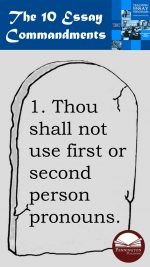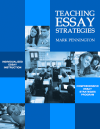Essay Rules: The Ten Commandments
Let’s begin by admitting that the academic essay is a mere construct. God did not provide Moses a tablet containing the five-paragraph essay format. Do a quick search of the most popular historical essays, and none will even remotely look like what you and I teach our students.
That being said, teaching the essay rules does make sense. When teachers provide an ideal in terms of guidelines (for example, “Write on only one topic”); when teachers provide restrictions and rules (for example, “Use no first and second person pronouns, and begin the conclusion with a thesis re-statement”); and when teachers clearly delineate the differences between, say, an argumentative essay (CCSS W1.0) and an informational/explanatory essay (CCSSW2.0), these essays become more comprehensible to their readers.
If we encourage writers to compose with their audience in mind, it makes sense to follow the expected norms of communication. When we hear a joke about three people walking into a bar, we expect the punchline to occur after the third entry, not the first or second. If we read a comic strip, we expect that the ending frame will leave a finished feel to that particular comic. If we listen to a message in church, mosque, or temple, we expect an application to our own lives to follow the scriptural text. If we watch a romantic comedy, we choose that genre with same expectations as everyone else.
In other words, teaching the essay rules helps the writer and is considerate to the reader.
Of course, we also teach the rules so that mature writers can intentionally break the rules when necessary to their purposes.
The 10 Essay Commandments
- Don’t go beyond the limitations of the writing prompt. Follow directions and don’t read into the assigned writing task what is not there. Check how How to Dissect a Writing Prompt to teach students how to do so independently.
- Keep writing consistent with the type of essay. For example, don’t add opinion (as is necessary in the W1.0 argumentative essay) in the W2.0 informational/explanatory essay.
- Properly cite all sources. An academic essay requires textual citations to avoid plagiarism.
- Write in third person. Talk about the essay topic. Don’t personalize the essay with first person pronouns such as I, me, my, mine, we, us, our, ours, ourselves. Don’t address the reader with second person pronouns such as you, your, yours, yourself, yourselves. Essays must remain objective (fair and balanced), not subjective (personalized). Therefore, essays shouldn’t use “I think,” “I believe,” and “In my opinion.”
- Don’t abbreviate. Abbreviations are part of informal writing. They don’t belong in essays. Write United States of America, not U.S.A. in essays.
- Don’t use slang, such as kids. Use official, or formal, words, such as students, adolescents, or children.
- Don’t use contractions. Again, essays are very formal, so write “can not” rather than “can’t.”
- Don’t use figures of speech. Use precise academic language in essays. Essays do not use poetic devices or idiomatic expressions. For example, don’t write “He really blew it.” Instead, say “He made a mistake.”
- Don’t over-use the same words or phrases. For example, avoid over-use of the “to-be” verbs: is, am, are, was, were, be, being, been.
- Include all three structural components of the traditional essay: an introduction, body paragraphs, and a conclusion.
Find 8 complete writing process essays (4 argumentative and 4 informational-explanatory) with accompanying readings, 42 sequenced writing strategy worksheets, 64 sentence revision lessons, additional remedial worksheets, writing fluency and skill lessons, posters, and editing resources in TEACHING ESSAYS BUNDLE. Also get the e-comments download of 438 writing comments to improve written response and student revisions.

